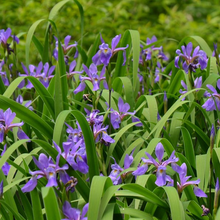Iris versicolor is a striking wetland perennial known for its bold violet blue flowers with intricate veining and sword shaped green leaves. Native to wet meadows and pond edges, it naturally grows in clumps and produces multiple blooms on each sturdy stalk. The plant has a long history of medicinal and cultural use by Indigenous peoples and attracts attention even when not in bloom due to its architectural foliage and tidy form.
Height & Spread: 24 - 36 in x 12 - 24 in
Bloom Time: Late spring to early summer
Light Requirements: Full sun to part sun
Soil Preference: Wet to consistently moist soils, including clay and muck
Watering Needs: High; prefers constant moisture or shallow standing water
Deer Resistance: Rarely browsed by deer due to bitter compounds in the foliage
Native Status
This species is native to eastern and central North America, commonly found in marshes, swamps, streambanks, and wet meadows.
WILDLIFE & INSECTS
Butterflies
- Visited by butterflies such as Monarchs and Red Admirals seeking moisture and minerals at the plant base.
Bees
- Pollinated by long tongued bees including bumblebees and digger bees that can navigate the flower’s complex shape.
Moths
- Provides nectar to night flying moths such as the Virginia Ctenucha which are drawn to its late day blooms.
Birds
- Dense foliage offers cover to wetland birds and the seeds are occasionally consumed by waterfowl like Mallards and Wood Ducks.
Spacing & Landscape Use
Spacing Recommendations:
- Space 18 - 24 in apart to allow room for spreading rhizomes and natural clumping.
Landscape Placement:
- Ideal for pond margins, rain gardens, wet prairies, and swales. Effective in naturalistic groupings and habitat restorations where moisture is abundant.
Companion Plants
- Caltha palustris (Marsh Marigold) - Produces early yellow blooms that contrast beautifully with Iris and thrive in saturated soils.
- Physostegia virginiana (Obedient Plant) - Adds vertical spikes of pink or white flowers and tolerates wet conditions well.
- Asclepias incarnata (Swamp Milkweed) - Supports Monarchs while adding soft pink blooms to wet meadows and shorelines.
- Lobelia siphilitica (Great Blue Lobelia) - Provides deep blue late season color and grows well alongside Iris in wet soil.
- Verbena hastata (Blue Vervain) - Towers above with branched purple spikes and draws a range of pollinators in moist habitats.



